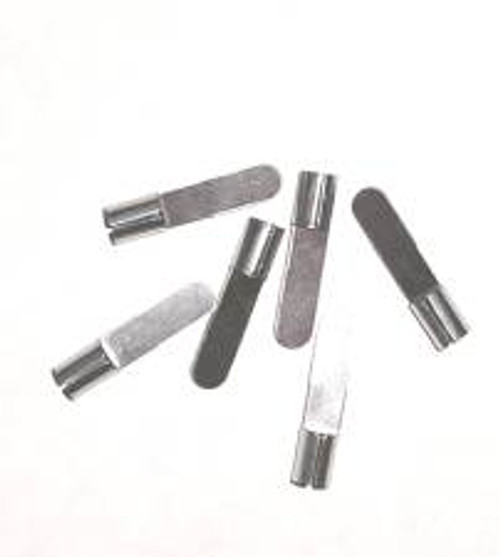25 JC Products Stainless Steel Reeds. These are single reed voice, .0025 thick. Used by call makers as loud volume cottontail distress, etc. JC Products reeds are the industry standard and used by almost every manufacturer of game calls (Circe, Primos, Sceery, Modern Call Products, Dan Thompson, Johnny Stewart, etc). Voice bodies have a true diameter of .200" with a .010" taper for a snug fit. Great deal for the hobbyist call maker. Reed insertion tool is NOI included. IMPORTANT! We strongly recommend you purchase the Call Builder Aluminum Reed Insertion Tool SKU 21952 ($2.49 ea) LINK HERE to aid in installing the reeds without damage to the delicate reed material. It is a must have for call builders
JC PRODUCT REED INFORMATION:
The JC Product voice systems are made for game calls, used for hunting predatory and non predatory animals. Other applications include noisemakers for professional collage or high school sports teams. Other diverse applications include fail safe air actuated alarms for ICU systems and fire alerts. All of our products are made and assembled in Arizona.
In order to enhance the variations of sound tone and decibels we offer 7 different tapers, 46 styles equaling 322 combinations. Voice units are pre-tuned to exact specifications as indicated below.
Taper ID scale
SV - no added bend or taper
MV - .005 increased bend or taper
LV - .010 increased bend or taper
1V - .020 increased bend or taper
2V - .030 increased bend or taper
3V - .040 increased bend or taper
4V - .050 increased bend or taper
Reed Thickness .002/.0025/.003/.005/.007/.010
Reed materials include stainless, brass and mylar
There are a multitude of factors that will change or manipulate sound.
1. Intake air flow across the voice coupled with exhaust or the back pressure are two factors to consider when designing a game call. Measured intake and backpressure cause pitch and tone variation.
2. Position or location of the voice within the barrel or mechanism causes differential pressure. Depending on voice location the intake and exhaust pressures are affected.
3. Blading a service we offer is a process by which a measured shim is inserted under the reed and then removed causing a permanent lift of the reed and changing the tone.
4. A dimpled reed allows for partial separation between reeds on a twin reed voice. It also allows both reeds to play or make sound during actuation.
5. Increasing the taper or bend will amplify the range or sound decibel (db) allowing the voice to handle more air movement or pressure.
Mixing the tapers, materials, thickness, blading, intake and backpressure create an unlimited sound range that is only limited to your product development program.
Voice bodies are non-corrosive; the exhaust port O.D. is .200 with a .010 taper for a rigid compression fit.
How to understand or read a complete reed part number: The first group of letters or numbers is the taper ID. The letter DR stands for dimpled reed. The last group or numbers are reed thicknes
| |








